Economic Activities Notes 12th Geography
12th Geography Lesson 4 Notes in English
4] Economic Activities
Introduction
- A new development was the unveiling of a new prototype vehicle in 2014, capable of being a fully self-driving car.
- These intelligent cars use sensors and soft ware to detect objects like pedestrians, cyclists and can safely drive around them.
- According to Google, the car can process both map and sensor information to find out its exact location – precisely which street or lane it is driving in.
- The sensors are so powerful that it can detect all kinds of objects.
- What’s more interesting, the soft ware can predict what these objects around the car will do next and take action accordingly.
- In an instance, where the traffic signal turned green and the car was about to move forward, the car sensed an ambulance coming from the right side and it stopped, making way for the ambulance.
- Google calls its cars, ‘experienced drivers’. Each car’s speed is capped safely at 25 mph (40 km/hr).
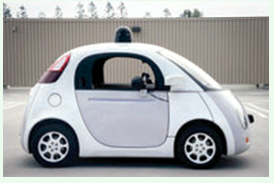
- The cars halt for 1.5 seconds after the signal turns green at a junction as many accidents happen during this time.
- But the cars can travel as fast as 161 km/hr.
- To ensure safety, the front side has about 2 feet of foam and the windshield is made of plastic instead of glass.
- This is the amazing product of secondary industries which we learn about as part of economic activities in this lesson
- Economic activity refers to the activity of making, providing, purchasing and selling goods or services.
- Economic activities exist at all levels within a society. Human beings are engaged in various kinds of economic activities.
- In general all the economic activities are broadly categorised into Primary, Secondary and Tertiary activities.
- The Tertiary activities are further sub divided into Quaternary and Quinary activities.
- Let us first understand the meaning and concept of the different categories of economic activities.
Types of Economic system:
1. Subsistence economy:
- Goods and services which are created for the use of the producers and their kinship groups.
2. Commercial economy:
- Goods and services which are produced mainly for sale.
- Market competition is the primary force determining the production and distributions.
3. Planned economy:
- Goods and services created are controlled by government agencies.
- Supply and price are controlled by the state.
- It was practiced earlier by the Communist controlled societies.
Primary activities
- Primary activities help man to fulfill his needs and desires, by using resources which are gifted to man by nature.
- These activities are directly connected with nature.
- Hunting, Gathering, Pastoralism, Fishing, Forestry, Mining and Agriculture are the primary activities.
Hunting and Gathering
- Until 12,000 years ago, all humans lived as hunters and gatherers.
- At present only 0.0001% human live as hunters and gatherers.
- Gathering and hunting are the oldest known economic activity in the world.
- It often involves primitive societies which collect both plants and animals to satisfy their needs for food, shelter and clothing.
- These primitive activities are being carried out still in a very few parts of the world.
- Gathering is practiced in the areas of High altitude zones of Northern Canada, Northern Eurasia and Southern Chile and in the low altitude zones of the Amazon Basin, Tropical Africa, Northern fringe of Australia and interior parts of South East Asia.
- Present day gatherers and hunters are confined to a few pockets.
- Inuit in the Arctic region, Pygmies of Kalahari, Pintupi, Aborgines of Australians, and Paliyan of South India are the examples of foragers.
Pastoralism
- Pastoralism is the process of grazing and rearing of different types of animals like cattle, sheep, goats, etc in an organised manner to get animals products.
- The animals rearing can be primitive which is carried on by nomads or highly scientific means on a commercial scale.
- So, animal grazing and rearing can be divided into two broad categories as Nomadic Herding and Commercial Livestock Rearing.
Nomadic Herding (or) Pastoral Nomadism
- It is a primitive subsistence activity in which the herders rely on animals for food, clothing, shelter, tools and transport.
- They move from place to place along with their livestock, depending on the availability of pastures and water.
- These people do not lead a settled life but keep on moving from place to place.
- Pastoral nomadism is commonly practiced in regions with little arable land, typically in the developing world.
- They are mostly found in central and western Asia, Northern and Western regions of Africa and some parts of southern Africa and Tundra regions.
Transhumance
- Transhumance is the seasonal movement of people with their livestock between fixed summer and winter pastures.
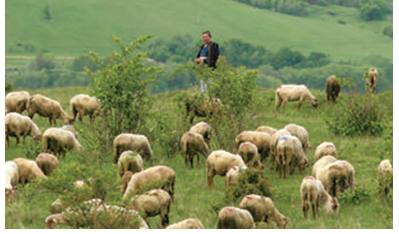
- In mountain region it implies movement between higher altitude pastures during summer and valleys in winter.
- Gujiars, Bakarwals, Gaddis and Bhotiyas in the Himalayan region migrate from plains to the mountain in summer and to the plains from the high altitude pastures in winter.
- In the tundra regions, herders move from south to north in summer and from north to south in winter.
- The number of pastoral nomads has been decreasing and the areas operated by them shrinks due to developments and spreading of other economic activities.
Commercial Livestock Rearing
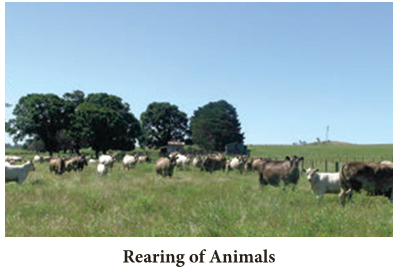
- Commercial livestock rearing is more organised and capital intensive activity in comparison with the Nomadic pastoralism.
- It is generally practiced in permanent ranches.
- Ranches refer to the large stock farms, usually fenced in, where animals are breed and reared on a commercial scale.
- Animals are grazed over large areas which are known as ranches in Prairies and estancia in Pampas.
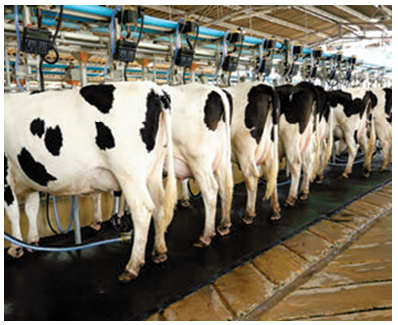
- Most modern technology is used for commercial grazing, great emphasis is laid on breeding, genetic improvement, disease control and health of the animals.
- Products such as meat, wool, hides and skin are processed and packed scientifically and exported to different world markets.
- New Zealand, Australia, Argentina, Uruguay and USA are the major countries where commercial livestock rearing is practiced.
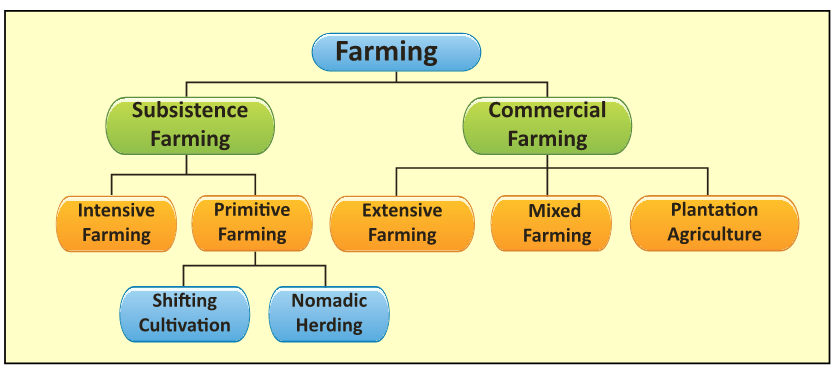
Agriculture
- Agriculture is the most fundamental form of human activity and includes not only cultivation of crops but also the domestication of animals.
- The following are the major agricultural types and their characteristic features.
Shifting Cultivation
- Shifting Cultivation is a kind of traditional farming practiced by tribes in the hilly and forest regions.
- It is practiced especially in tropical Africa.
- In this farming an area of ground is cleared of vegetation and cultivated for a few years and then abandoned for a new area until its fertility has been naturally restored.
- They are called with different names in different regions as follows Shifting Cultivation in Northeast India.
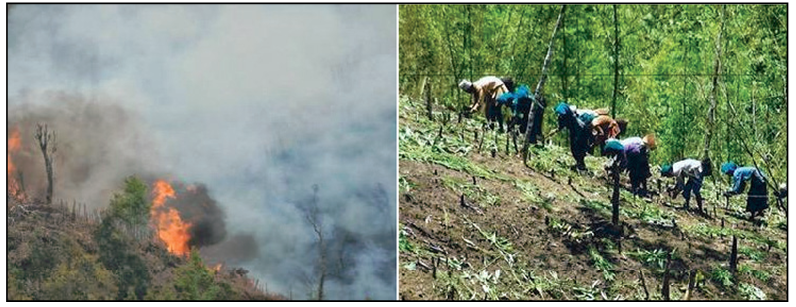
Employees of the economic activity called as
| Economic Activity | Name |
| Primary | Red collar |
| Secondary | Blue collar |
| Tertiary | Pink collar |
| Quaternary | White collar |
| Quinary | Gold collar |
| S. No | Name | Region |
| 1 | Jhuming / Bewar | North eastern states of India |
| 2 | Ladang | Malaysia |
| 3 | Chengin / Kaingin | Philippines |
| 4 | Milpa | Central America and Mexico |
| 5 | Konuko | Venezuela |
| 6 | Roca | Brazil |
| 7 | Masole | Congo |
| 8 | Ray | Vietnam |
| 9 | Humah | Indonesia |
| 10 | Taungya | Myanmar |
| 11 | Chen | Sri Lanka |
- Subsistence Agriculture is a type of farming in which output is consumed almost entirely by the farmers and their families leaving only a small proportion for sale.
- Farmers follow traditional method of cultivation in this kind of farming.
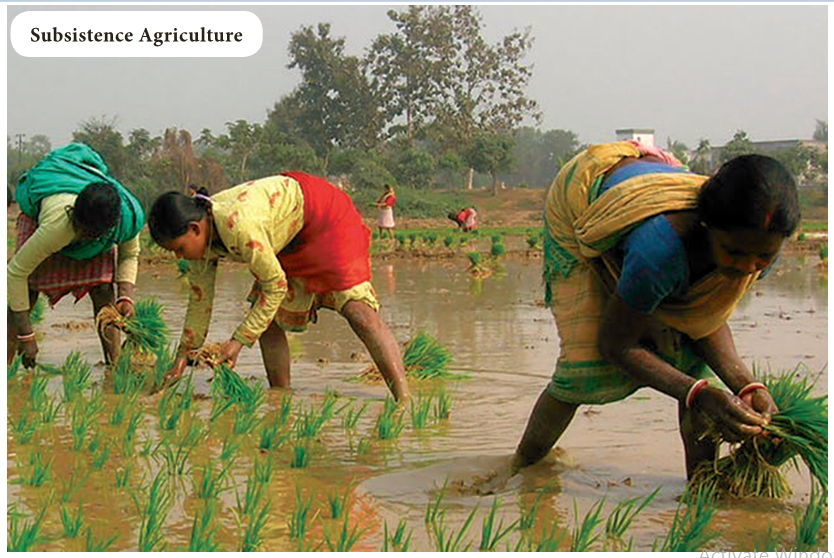
- Intensive Agriculture is the one in which the agricultural land is utilised intensively.
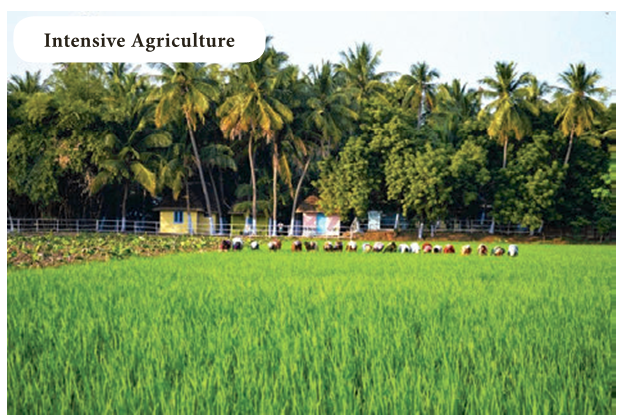
- Farmers prefer the cultivation of short duration crops which enables the cultivation of two or three crops in the same piece of land in a year.
- Generally it is practiced wherein the size of the agricultural land holding is small.
Plantation Agriculture
- Plantation agriculture is a form of commercial farming where crops are grown for profit.
- Large land areas are needed for this type of agriculture.
- Countries that have plantation Agriculture usually experience high annual temperatures and receive high annual rainfall.
- Plantation is mainly found in countries that have a tropical climate.
- The important plantation crops are tea, coffee, cocoa, rubber, oil palm, sugarcane, bananas and pineapples.

Extensive Farming
- It is a kind of farming practiced in the regions where the size of the land holding is very large.
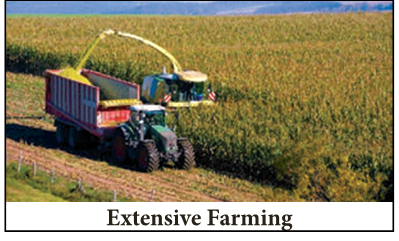
- It is practiced in the Interior parts of semi-arid lands of the mid-latitudes.
- Wheat is the major crop of this region and the farming is highly mechanized.
Mixed Farming
- It is an agricultural system in which a farmer conducts different agricultural practice together, such as crops, fishing and livestock.
- The aim is to increase income through different sources and to complement land and labour demands across the year.
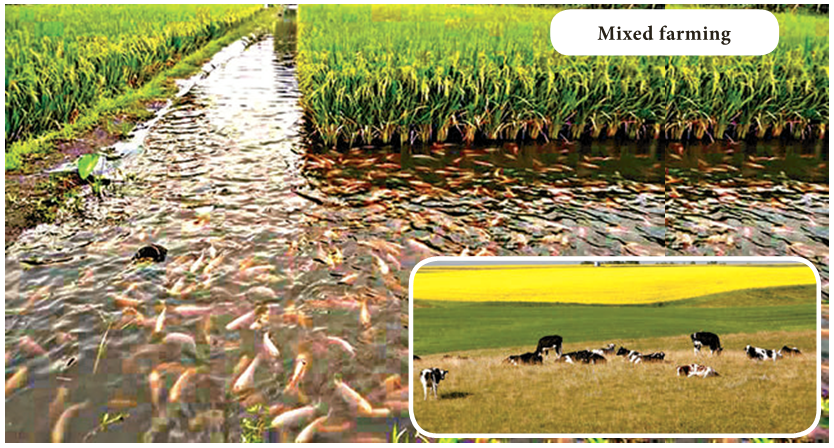
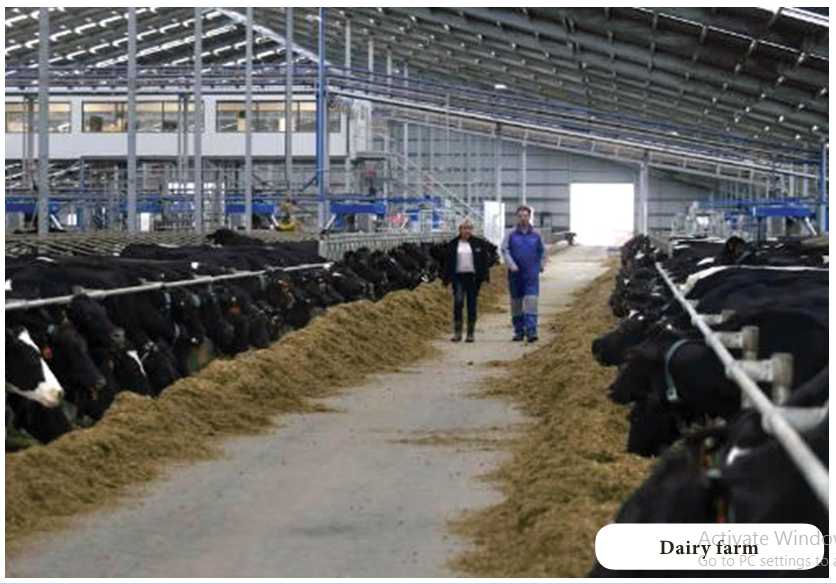
Mediterranean Agriculture
- Mediterranean agriculture is highly specialised commercial agriculture.
- It is practised in the countries on either side of the Mediterranean Sea in Europe and in North Africa from Tunisia to Atlantic coast, southern California, central Chile, south western parts of South Africa and south and south western parts of Australia.
- This region is an important supplier of citrus fruits. Viticulture or grape cultivation is a speciality of the Mediterranean region.
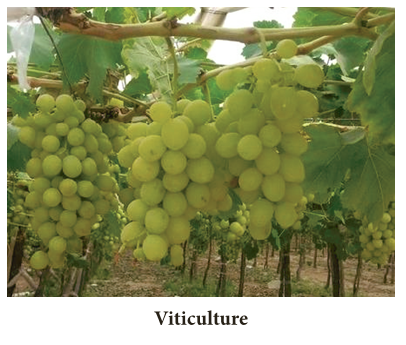
- Best quality wines in the world with distinctive flavours are produced from high quality grapes in various countries of this region.
- The inferior grapes are dried into raisins and currants. This region also produces olives and figs.
- The advantage of Mediterranean agriculture is that more valuable crops such as fruits and vegetables are grown in winters when there is great demand in European and North American markets.
Horticulture
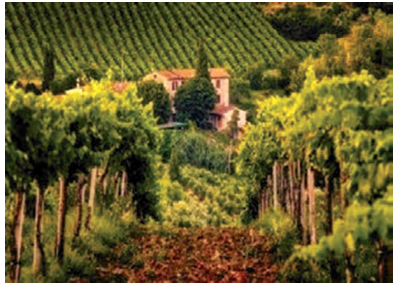
- Specialised cultivation of flowers, vegetables and fruits is called horticulture. It is also termed as “truck farming”.
- These crops are grown on small farms which are well connected to the markets by cheap and efficient means of transportation.
- It is labour and capital intensive crops.
- The main areas are northwest Europe, northern eastern USA and Mediterranean region.
- The study of grape cultivation is known as viticulture.
Von Thunen model of agriculture
- The Von Thunen model of agricultural land use was created by the farmer, landowner, and economist Von Thunen in 1826 in a book called The Isolated State.
- Von Thunen model was created before industrialization and is based on the following limiting assumptions: The city is located centrally within an “Isolated State” that is self-sufficient and has no external influences.
- The Isolated State is surrounded by an unoccupied wilderness.
- The land of the State is completely flat and has no rivers or mountains to interrupt the terrain.
- The soil quality and climate are consistent throughout the State.
- Farmers in the Isolated State transport their own goods to market via ox cart, across the land, directly to the central city.
- Therefore, there are no roads. Farmers act to maximize profits.
- Ranching and Livestock
- Grains and Field Crops
- Forests
- Dairy Farming
- Market Gardening
- Urban Centre Market
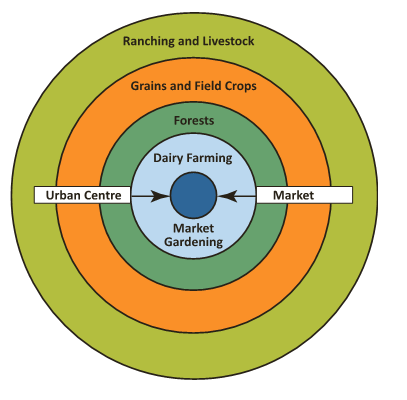
- In an Isolated State with the foregoing statements being true, Von Thunen hypothesized that a pattern of rings around the city would develop based on land cost and transportation cost.
The Four Rings
Ring 1:
- Dairying and intensive farming occur in the ring closest to the city.
- Because vegetables, fruit, milk, and other dairy products must get to market quickly, they would be produced close to the city.
- The first ring of land is also more expensive, so the agricultural products would have to be highly valuable ones and the rate of return is maximized.
Ring 2:
- Timber and firewood would be produced for fuel and building materials in the second zone.
- Before industrialization and coal power, wood was a very important fuel for heating and cooking.
- Wood is very heavy and difficult to transport, so it is located as close to the city as possible.
Ring 3:
- The third zone consists of extensive field crops such as grains for bread.
- As grains last longer than dairy products and they are much lighter than fuel, to reduce transport costs, they can be located farther from the city.
Ring 4:
- Ranching is located in the final ring surrounding the central city.
- Animals can be raised far from the city because they are self-transporting.
What the Model Tells Us?
- Even though the Von Thunen model was created in a time before factories, highways, and even railroads, it is still an important model in geography.
- The Von Thunen model is an excellent illustration of the balance between land cost and transportation costs.
- When one gets closer to a city, the price of land increases.
- The farmers of the Isolated State balance the cost of transportation, land, and profit and produce the most cost-effective product for market.
- Of course, in the real world, things do not happen as they would in a model.
Mining
- The process of extracting minerals from the earth crust is known as mining.
- The discovery of minerals in the history of human development is reflected in many stages in terms of copper, Bronze and Iron age.
- The use of minerals in ancient times was largely confined to making of tools, utensils and weapons.
- The actual development of mining began with the industrial revolution and its importance is continuously increasing.
Types of Mining
Open-pit or opencast mining
- Open pit mining involves mining minerals ore that can be found near the surface layer of the site.
- Some quarries can be over 1000 meters deep.
- This form of mining doesn’t require tunneling into the earth and is a simple method of mining that yields high production.
Surface Mining
- Surface mining is the process of mining the ores found on the surface of the earth.
- In this process, any unwanted soil is stripped off from the land and the ore beneath is extracted.
- Surface mining often leaves behind large areas of infertile land and waste rock as 70% of the mined earth is waste materials.
Underground or sub surface mining/Shaft mining
- Sub-surface mining involves the digging of a network of shafts and tunnels into the earth to reach and extract the deposit of mineral ore beneath the earth.
- In comparison to other methods, underground mines impacts are less on the environment and are more harmful to those working within them.
- In modern practice, underground mines are pre-assessed for oxygen toxicity levels and a system of ventilation machines and protocols are in place to ensure workplace safety.
In-Situ Mining
- It is a rarely used method of mining material. It is also called as solution mining.
- It is the process of pumping a solution into the ore body, which dissolves the ore and is then extracted by a second pump.
- This method is used most in mining uranium deposits.
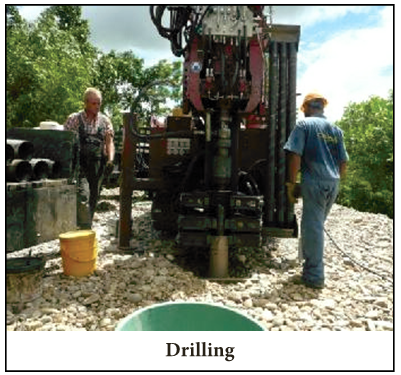
Secondary Activities
- Secondary sector transforms the raw materials obtained from the primary sector into consumer goods.
- So it consists of manufacturing and industrial activities.
- Since it adds value for the raw materials, it is also called as value addition sector.
- Industries consume large quantities of energy and require factories and machinery to convert the raw materials into goods and products.
- The secondary sector supports both the primary and tertiary sectors.
Factors affecting location of Industries
1. Availability of raw-materials or nearness to raw-materials:
- Availability of raw materials or nearness to raw materials is a primary factor which governs location of industries.
- An industry is located in a place where raw materials are available in abundance and at cheaper rates.
- It is more so for the weight loosing and bulky raw materials.
- For example, oil refinery factories are established at Visakhapatnam because oil is imported through Vizag port.
2. Availability of power:
- Availability of power is another important factor of concentration or location of industries.
- In olden days steam was used for running industries.
- As a result industry is established near the coal mines.
- But with the invention of electricity, today industries are located in any place where electricity is available.
- Industries like aluminum units are located near the hydroelectric projects.
3. Transport costs
- Transport costs also influence the location of industries.
- Industries incur transport costs for bringing raw-materials and for sending the finished goods into the markets.
- It is economical to start an industry near the area where transport costs are minimum and low.
- Raw-materials which are heavy and occupy large place, require huge cost for transporting them.
- So an industry must be located near the area where the transport costs are minimal.
4. Nearness to the market:
- This is a chief factor governing the location of an industry in modern period.
- Several advantages are secured when an industry is established near the market.
- Production can be carried on in accordance with the changes in the consumers’ tastes.
- Economies of transport can be secured in importing raw-materials.
5. Availability of labour:
- Labour is required for organizing the productive affairs of an industry.
- The entrepreneurs like to start industries in those areas where labour is abundantly available.
- The growth of cotton textile industry near Bombay is due to the availability of cheap labour.
6. Government policy:
- The policy of government also influences the location of industries.
- The Government may establish an industry on political considerations by giving several incentives.
- It provides finance, land, water, and transport and communication facilities in backward regions with a view to developing them.
- It also provides tax concession, marketing consultancy, export and import facilities.
7. Availability of capital:
- Capital is the most essential factor for the establishment of an industry in a locality.
Weber’s Theory of Location
- Weber has developed an industrial location emphasising the least cost principle.
- This is based on assumptions relating to transport costs and other conditions.
- From his theory, industrial locations for three different situations are made clear.
Assumptions:
- Some resources are available only in certain regions. Yet, resources such as water are ubiquitous (present everywhere).
- Markets are found only in specific places.
- Transport costs are determined based on the weight of the raw materials and distance of transfer.
- There is competition in the markets for the commodities produced at the industry.
- Humans use their discretion in their consumer behaviour in relation to the industrial commodities.
Theory of Industrial location
- Based on these assumptions, together with the notion of high profits with least costs and imagination, Weber describes his theory of industrial location.
- Weber uses a triangular structure to elaborate on his theory of industrial location using least transport cost principle.
- The two corners of the triangle defined by the base line represent the places where raw materials are found (R1 and R2).
- The market (M) is at the apex of the triangle. In the figure below, R1 and R2 are resource locations, consisting of two types of resources.
- M is the market and P is the industrial location.
- As the logic behind Weber’s location indicates, some industries produce finished products which lose weight (weight losing raw materials).
- In this case, the transport cost for raw materials transfer to the industrial location is higher than the transport cost of moving finished products from industrial location to market.
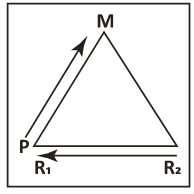
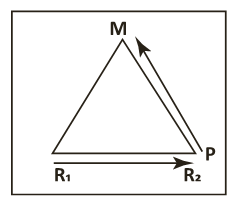
- It is because the waste from raw materials at the industrial site will be high. Hence, it is profitable to have industry at the raw materials’ locations.
- If industry is located at the raw material source R1, then raw material R2 must be transported to industrial location R1 and the finished products must be transported to the market M.
- This results in transport costs. Likewise the industry could be located at R2, too. But if it is located at M, R1 and R2 resources must be transported to market M. This would also involve transport costs.
- If on the other hand, the industry is located half way between R1 and R2, and then the transport cost to bring the raw materials from R1 and R2 is equal.
- Transport cost involved in transporting the finished products to the Market decreases because of small distance to market M (if transport cost is assumed to increase with distance).
- In the final analysis, the transport cost for raw materials to the industrial location P and the finished products to market M from P together is the least when industry is located at P.
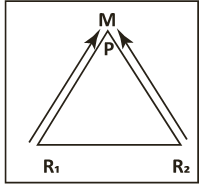
- There is thus a chance for increased profit for the industry.
- The triangle at top left represents a location where distance to be covered by transport is at minimum, the triangle at the top right illustrates the location of a ‘weight – losing industry’ and the triangle at the bottom left represents the location of a ‘weight – gaining industry’.
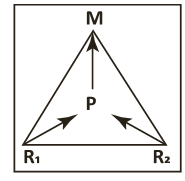
- Hence, the location of industry at P is an ‘optimal industrial location’.
- As the industry is located at a point between the raw materials locations, transport cost to transfer bulky raw materials is reduced considerably.
- The transport cost for transferring the finished products from the industry to the market is also small.
- In such a context, Weber believes that it is profitable to set up the industry at a location in between the industry.
- There are some industries which manufacture finished products gaining weight in the process.
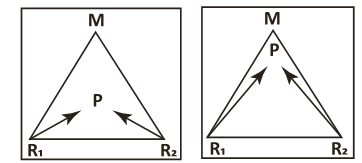
- The transport cost between raw materials location and industry is lower than the transport cost of finished products from industrial location to the market.
- It is logical therefore to locate the industry at the market.
- According to Weber, this location is more profitable to the industry than any other.
- The Weber’s location theory is that it is based on the transport cost.
- Nevertheless, this theory of industrial location is considered superior to other industrial location theories for its logical conclusion.
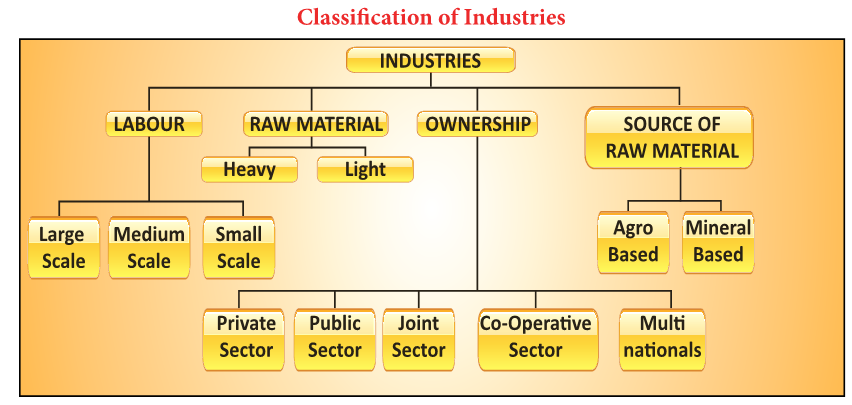
On the Basis of Labour
Large Scale Industries
- Industries which employ a large number of labourers with huge capital are called large-scale industries.
- Cotton and jute textile industries are large scale industries.
Small Scale Industries
- Industries which employ a small number of labourers with small investments are called small scale industries.
- They include nut & bolt making, coir making, plastic bags industries, dying industry, match box making, weaving industry are some examples for small scale industries
Cottage Industries
- Those industries whose labour force consists of family units or individuals working at home with their own equipments are called cottage industries.
- It is a small and often informally organized industry.
- The industries like weaving and pottery are the examples this category.
- On the Basis of size of raw-Material and Finished Goods
Heavy Industries
- Industries which use heavy and bulky raw-materials and produce products of the same category are called heavy industries.
- Iron and steel industry presents a good example of heavy industries.
Light Industries
- The light industries use light raw-materials and produce light finished products.
- Electric fans, sewing machines are light industries.
On the basis of Ownership
Private Sector Industries
- Industries owned by individuals or firms such as Bajaj Auto or TISCO situated at Jamshedpur are called private sector industries.
Public Sector Industries
- Industries owned by the state and its agencies like Bharat Heavy Electricals Ltd., or Bhilai Steel Plant or Durgapur Steel Plant are public sector industries.
Joint Sector Industries
- Industries owned jointly by the private firms and the state or its agencies such as Gujarat Alkalies Ltd., or Oil India Ltd. fall in the group of joint sector industries.
Co-operative Sector Industries
- Industries owned and run co-operatively by a group of people who are generally producers of raw materials of the given industry such as a sugar mill owned and run by farmers are called co-operative sector industries.
On the Basis of Source of Raw Materials
Agro Based Industries
- Agro based industries are those industries which obtain raw-material from agriculture.
- Cotton textile, jute textile, sugar and vegetable oil are representative industries of agro-based group of industries.
Mineral Based Industries
- The industries that receive raw materials primarily from minerals such as iron and steel, aluminium and cement industries fall in this category.
Pastoral-Based Industries
- These industries depend upon animals for their raw material.
- Hides, skins, bones, horns, shoes, dairy, etc. are some of the pastoral-based industries.
Forest Based Industries
- Paper card-board, lac, rayon, resin, tanning of leather, leave- utensils, basket industries are included in this type of industries.
Classification based on Nature of products
- Based on the nature of products it is classified into basic industries and consumer goods.
- Basic industries are manufacturing goods by using them as raw materials are basic industries.
- For example Iron and steel machines for textile industry.
- Consumer industries are producing goods for consumers.
- For example, Television, soap, biscuits, etc
Tertiary activities
- The tertiary industry provides services to its consumers. It is also known as service industry/sector.
- All types of services and special skills provided in exchange of payments are called tertiary activities.
- Health, education, law, governance and recreation etc; require professional skills.
- These services require other theoretical knowledge and practical training.
- Most of the tertiary activities are performed by skilled workers and professionally trained experts and consultants.
- Tertiary activities involve commercial output of services rather than the production of tangible goods.
- Expertise provided by service relies more heavily on special skills, experience and knowledge of the workers rather than on the production techniques, machinery and factory processes.
- Trade and commerce, transport, communication and services are the categories of tertiary sector.
- Tertiary sector is further divided into quaternary and quinary sector.
Quaternary Activities
- The quaternary sector of the economy consists of intellectual activities, example, libraries, scientific research, education, and information technology.
- The workforce who is readily involved in this sector is typically well- educated, and people are often seen earning well through their participation in this industry.
Quinary Activities
- The professions of the people working in this industry are generally referred to as “gold collar” professions since the services included in the sector focus on interpretation of existing or the new ideas, evaluation of new technologies, and the creation of services.
- It involves highly paid professionals, research scientists, and government officials.
- The people are designated with high positions and powers, and those who make important decisions that are especially far-reaching in the world around them often belong to this category.
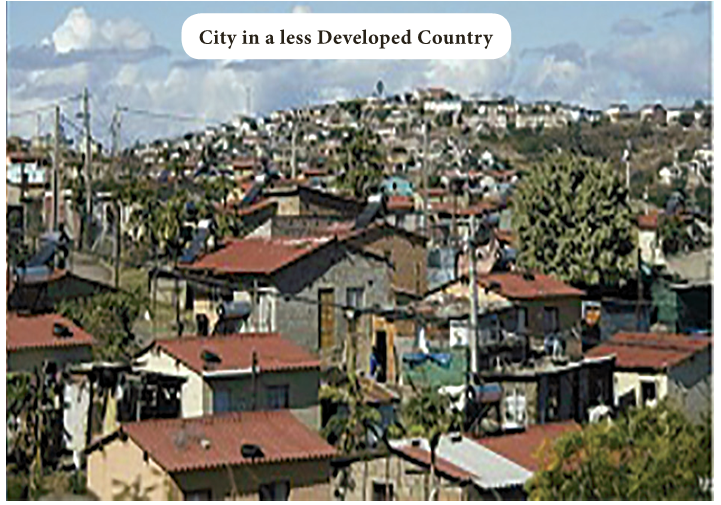
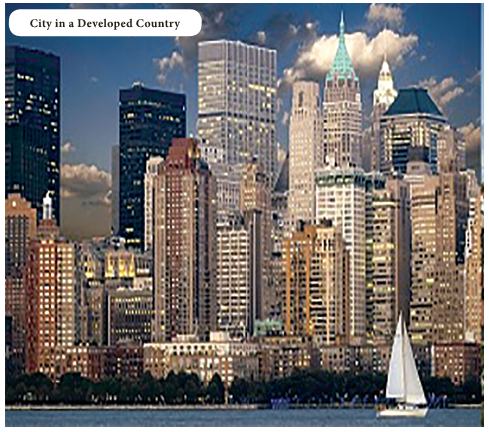
Division of the world
- For analytical purposes, World Economic Situation and Prospects classifies (WESP) all countries of the world into one of three broad categories: developed countries, countries in transition (South-Eastern Europe Commonwealth of Independent States and Georgia) less developed countries and developing countries.
- The classification of countries is based on the economic status such as Gross Domestic Product (GDP), Gross National Product (GNP), per capita income, industrialization, the standard of living, etc.
- Developed Countries refer to the sovereign state, whose economy has highly progressed and possess great technological infrastructure, as compared to other nations.
Developed countries
- A developed country, industrialized country, more developed country, or more economically developed country (MEDC), is a country that has a developed economy and advanced technological infrastructure relative to other less industrialized nations.
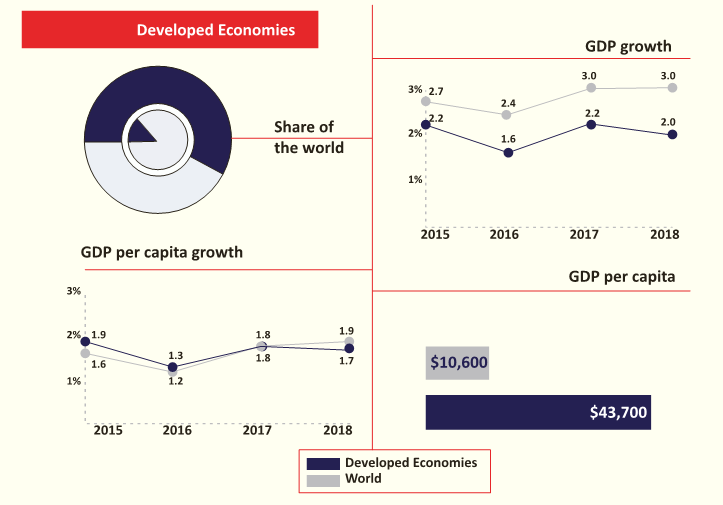
- Most commonly, the criteria for evaluating the degree of economic development are gross domestic product (GDP), gross national product (GNP), the per capita income, level of industrialization, amount of widespread infrastructure and general standard of living.
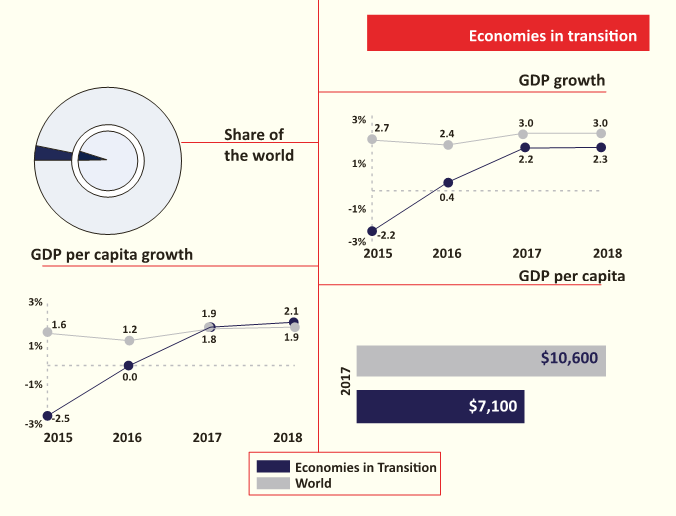
- Developed countries have generally post- industrial economies, meaning the service sector provides more wealth than the industrial sector.
- As of 2015, advanced economies comprise 60.8% of global GDP based on nominal values and 42.9% of global GDP based on purchasing-power parity (PPP) according to the International Monetary Fund.
- In 2017, the ten largest advanced economies by GDP in both nominal and PPP terms were Australia, Canada, France, Germany, Italy, Japan, South Korea, Spain, the United Kingdom, and the United States.
Countries in transition
- A country in transition economy or transitional economy is an economy which is changing from a centrally planned economy to a market economy.
- Transition economies undergo a set of structural transformations intended to develop market-based institutions.
- These include economic liberalization, where prices are set by market forces rather than by a central planning organization.
- The process has been applied in the former Soviet Union and Eastern bloc countries of Europe and some Third world countries, and detailed work has been undertaken on its economic and social effects.
The Least Developed Countries
- The Least Developed Countries is a list of countries that, according to the United Nations, exhibit the lowest indicators of socioeconomic development, with the lowest Human Development Index ratings of all countries in the world.
- A country is classified among the Least Developed Countries if it meets three criteria.
- Poverty – adjustable criterion based on GNI per capita averaged over three years.
- As of 2018 a country must have GNI per capita less than US$1,025 to be included on the list, and over $1,230 to graduate from it.
- Human resource weakness (based on indicators of nutrition, health, education and adult literacy).
- Economic vulnerability (based on instability of agricultural production, instability of exports of goods and services, economic importance of non-traditional activities, merchandise export concentration, handicap of economic smallness, and the percentage of population displaced by natural disasters).
The world’s 10 biggest economies in 2017
- The economy of the United States is the largest in the world.
- At $18 trillion, it represents a quarter share of the global economy (24.3%), according to the latest World Bank figures.
- China follows, with $11 trillion, or 14.8% of the world economy. Japan is in third place with an economy of $4.4 trillion, which represents almost 6% of the world economy.
- European countries take the next three places on the list: Germany in fourth position, with a $3.3 trillion economy; the United Kingdom in fifth with $2.9 trillion; and France in sixth with $2.4 trillion.
- India is in seventh place with $2 trillion, and Italy in eighth with an economy of over $1.8 trillion.
- Ninth place goes to Brazil, with an almost $1.8 trillion economy.
- And in 10th is Canada, with an economy of over $1.5 trillion.
- The economy of the United States is larger than the combined economies of numbers three to 10 on the list.
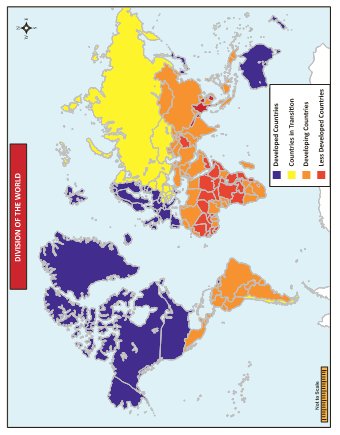
GDP share of World Economics
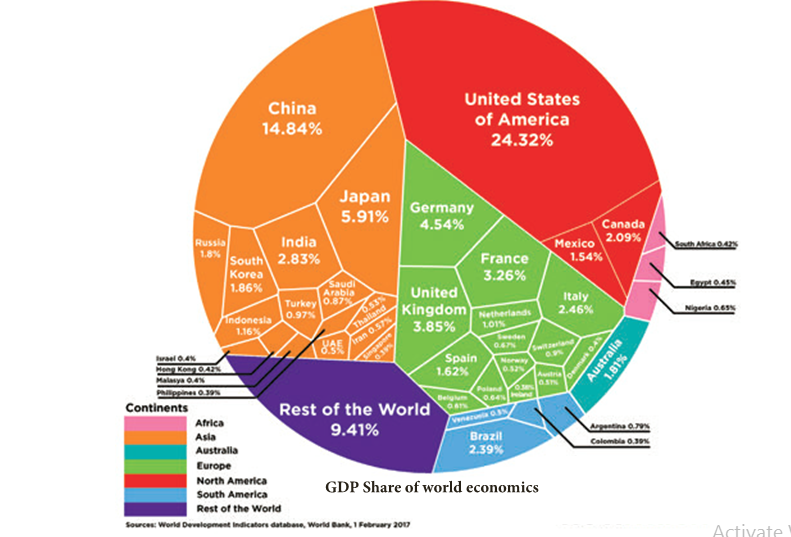
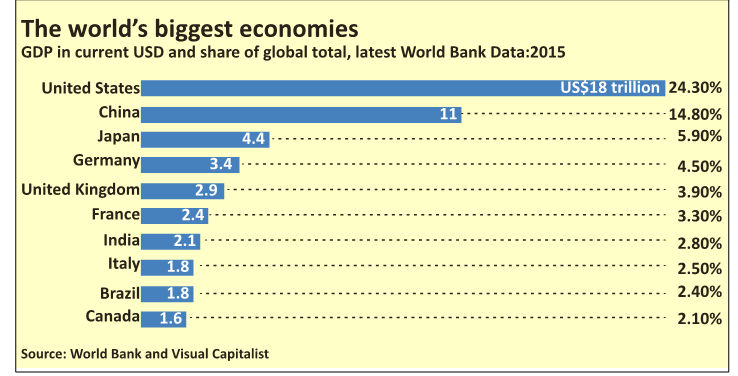
Fastest-growing economy
- Although China trails the US by $7 trillion, it’s catching up.
- China’s economy grew by 6.7% in 2016, compared with America’s 1.6%, according to the IMF.
- It has also overtaken India as the fastest- growing large economy.
- The IMF’s World Economic Outlook estimated China’s economy grew at 6.7% in 2016, compared with India’s 6.6%.
- The chart above shows the world’s 40 biggest economies individually, but grouped by colour into continents.
- The Asian bloc clearly has a larger share than anywhere else, representing just over a third (33.84%) of global GDP.
- That’s compared to North America, which represents just over a quarter, at 27.95%. Europe comes third with just over one-fifth of global GDP (21.37%).
- Together, these three blocs generate more than four-fifths (83.16%) of the world’s total output.
MORE TO KNOW:
- Pomology – the study of growing fruits.
- Olericulture – science of vegetable growing.
- Floriculture – refers to cultivation of flowers.
- Sericulture – refers to Rearing of Silkworms
